Making NGSS Storylines Work
By Cindy Workosky
Posted on 2018-04-24
I had eagerly anticipated a session at the NSTA National Conference in Atlanta called How Do We Make NGSS Storylines Work by Pushing Students to Go Deeper?—presented by Michael Novak and Brian Reiser—and I was not alone: Attendees filled the room to overflowing. I was fortunate to have worked with Novak and Reiser when I was a science coordinator in Vermont, and I was excited to learn more at their session. I was not disappointed. My understanding of how storylines can deepen student understanding of science continues to grow, and this session was valuable because it further enhanced my knowledge.
 Teachers are starving for quality resources, and Novak and Reiser inspired them to write their own 3-D lessons and suggested resources for doing so. They began with the basics of coherent storylines and how they differ from what most of us have always done: In the past, teachers just chose their favorite activities, which didn’t always help students make sense of the concept. Coherent storylines have a certain flow and a purpose for each learning experience.
Teachers are starving for quality resources, and Novak and Reiser inspired them to write their own 3-D lessons and suggested resources for doing so. They began with the basics of coherent storylines and how they differ from what most of us have always done: In the past, teachers just chose their favorite activities, which didn’t always help students make sense of the concept. Coherent storylines have a certain flow and a purpose for each learning experience.
The presenters described an interesting tool that included five questions they use to develop storylines for NGSS learning, and provided examples. I could hear many oohs and ahs around the room, and attendees asking one another questions and reflecting on their instructional approaches and how they could change.
The slide below is my favorite because it shows empathy for the stages where many educators are in their own transition to NGSS and encourages a can-do attitude. (download all the slides here)
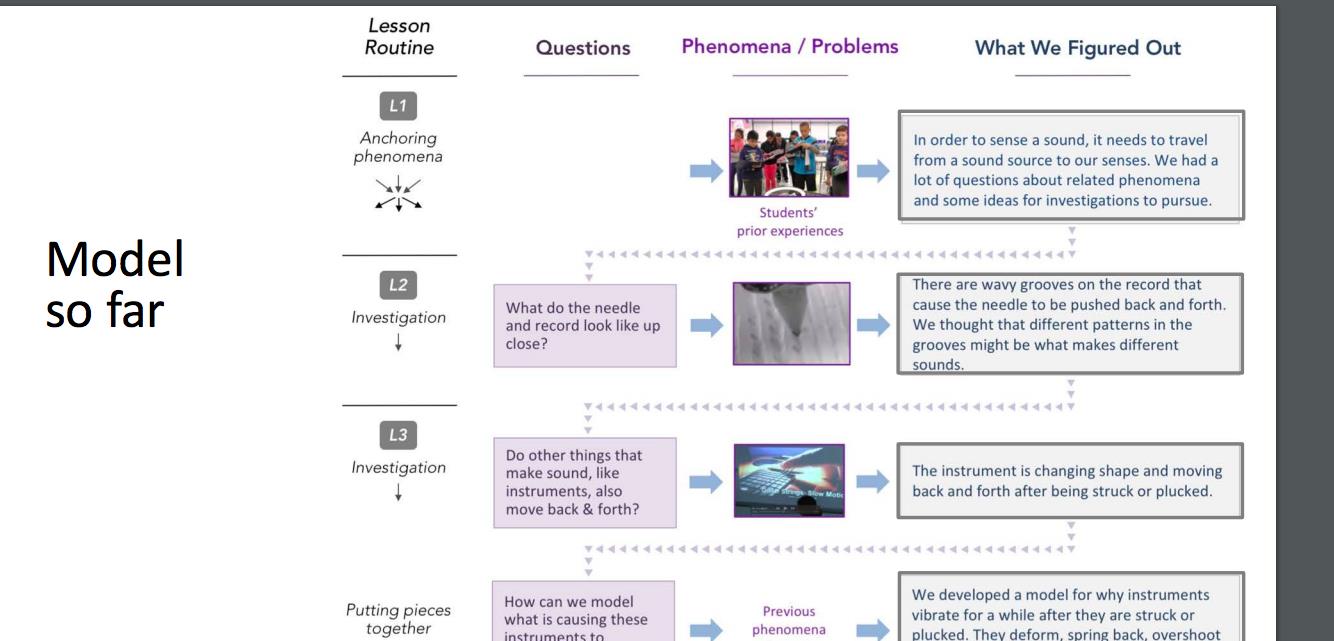
Notice that text on the left of the slide states “Model so far.” This language encourages educators to understand that taking a risk is okay: take a risk and try it. It is desirable to use this model and maybe make it even better.
I learned a new word in NGSS science thinking at this session: —problematizing. I believe that when we are problematizing, we are asking students to apply their learning to a new and different situation. By doing so, we give them an opportunity to bolster their understanding and/or ask new questions.
Fellow NGSS Squadsters Liza Rickey and Meg Richards also shared some insights about the session.
Richards had a different view of what problematizing is. It’s determining how to push students to dig deeper, to want to know more.
Rickey was also intrigued by the concept of problematizing and notes that sometimes it’s appropriate to introduce a new phenomenon or question to students who might not have been on driving question board. I agree. Helping students do this might be as simple as asking them for other examples of the phenomenon in their lives, while at other times, teachers might need to introduce a similar situation to help students comprehend the ideas. By doing this, students will think beyond the phenomena themselves and begin to realize why this concept is important beyond the classroom.
After talking with Richards, it was obvious to me that her biggest revelation was the power of student questions. She explained, “I knew wonder drove investigation, but I never thought about it also being the driver of the actual instruction of materials as well (i.e., kids using a microscope). I’m interested in seeing this in action, and even more excited to try it out myself.”
One of my epiphanies is recognizing that yes, students need to know how to use the tools of science to move their learning forward, but that can be accomplished by fostering and eliciting student questions about the tool rather than the teacher providing the answers as had been done in the past.
It’s important to ask questions as we engage in the productive struggle of learning this new way of thinking about science instruction. Novak and Reiser modeled that and invited participants to ask their own questions. Richards had many. The following is a visualization of her questions as a driving question board, with a driving question and many investigable questions that support it.
Her questions
“How can I/we start storylining in our classrooms efficiently and effectively?”
- In having student questions drive investigation, what happens to the questions that aren’t answered?
- How does one ensure students still feel valued?
- What do you do with the disengaged kiddo who “has no questions”?
- How does differentiation work in this model, and what does the grade book (ick!) look like?
- How do you involve and educate parents about the shifting methodology of instruction?
- How can we help students with effective instruction while also preparing them for the current inevitable college instructional strategies?
Do you see it the way I do? Maybe your visualization is different. Please share your thoughts about this.
I want to thank Liza Rickey and Meg Richards for their thoughtful responses to my question.
I have been developing NGSS curriculum for a while now, but Novak’s and Reiser’s work continues to advance my thinking. I now have a few questions of my own. How much time does it take to build storylines this way? How much time during the school day should be allocated for this type of learning?
I welcome your thoughts, ideas, and questions about this topic. Please share in the comment section below.
 Kathy Renfrew is field editor of the Next Gen Navigator. She is a science specialist and instructional coach as well as an NGSS@NSTA curator and online adviser in the NSTA Learning Center. She is a regular science blogger for The Teaching Channel and Middleweb. You can always find her seeking out new learning on Twitter and other social media. Her Twitter handle is @krsciencelady. Kathy previously taught grades 4 through 6 in a self-contained classroom for more than 30 years. She served as a state science supervisor in Vermont for eight years. She is a National Board Certified Teacher and a 2000 recipient of the elementary Presidential Award for Excellence in Science Teaching.
Kathy Renfrew is field editor of the Next Gen Navigator. She is a science specialist and instructional coach as well as an NGSS@NSTA curator and online adviser in the NSTA Learning Center. She is a regular science blogger for The Teaching Channel and Middleweb. You can always find her seeking out new learning on Twitter and other social media. Her Twitter handle is @krsciencelady. Kathy previously taught grades 4 through 6 in a self-contained classroom for more than 30 years. She served as a state science supervisor in Vermont for eight years. She is a National Board Certified Teacher and a 2000 recipient of the elementary Presidential Award for Excellence in Science Teaching.
This article was featured in the April issue of Next Gen Navigator, a monthly e-newsletter from NSTA delivering information, insights, resources, and professional learning opportunities for science educators by science educators on the Next Generation Science Standards and three-dimensional instruction. Click here to read more from the April issue. Click here to sign up to receive the Navigator every month.
Visit NSTA’s NGSS@NSTA Hub for hundreds of vetted classroom resources, professional learning opportunities, publications, ebooks and more; connect with your teacher colleagues on the NGSS listservs (members can sign up here); and join us for discussions around NGSS at an upcoming conference.
The mission of NSTA is to promote excellence and innovation in science teaching and learning for all.
Future NSTA Conferences
2018 STEM Forum & Expo
Dive into Three-Dimensional Instruction Workshop
2018 Area Conferences
2019 National Conference
Follow NSTA
I had eagerly anticipated a session at the NSTA National Conference in Atlanta called How Do We Make NGSS Storylines Work by Pushing Students to Go Deeper?—presented by Michael Novak and Brian Reiser—and I was not alone: Attendees filled the room to overflowing. I was fortunate to have worked with Novak and Reiser when I was a science coordinator in Vermont, and I was excited to learn more at their session.
Scaffolding the Crosscutting Concepts: Graphic Organizers in Action in the Middle School Classroom
By Cindy Workosky
Posted on 2018-04-24
The crosscutting concepts have great potential to help students connect their learning across grade levels and science disciplines, but they can easily become the forgotten “third dimension.” Last May, we wrote about developing a set of graphic organizers that help make the crosscutting concepts explicit for students and scaffold their thinking as students apply the crosscutting concepts to scientific phenomena. At the recent NSTA National Conference in Atlanta, we were excited to share the experiences of middle school teachers who piloted the graphic organizers with their students. You can find our presentation materials on the Conferences section of NSTA’s website (search any of our last names), or click here. In the following paragraphs, each teacher shares a brief reflection on her experience.
Sixth-Grade Earth Science—Ducks Overboard (Systems and System Models) by Jessica Caldwell.
 I have been teaching science for seven years in rural northeast Georgia, which probably has more chickens than people. For my lesson about ocean currents, I incorporated the rubber ducks overboard phenomenon. In 1992, thousands of ducks went overboard in the middle of the Pacific Ocean, and have been washing ashore worldwide. Students explored this by reading made-up text messages from around the world to get the longitude and latitude, then plotting where the ducks were found.
I have been teaching science for seven years in rural northeast Georgia, which probably has more chickens than people. For my lesson about ocean currents, I incorporated the rubber ducks overboard phenomenon. In 1992, thousands of ducks went overboard in the middle of the Pacific Ocean, and have been washing ashore worldwide. Students explored this by reading made-up text messages from around the world to get the longitude and latitude, then plotting where the ducks were found.
Next, we read about ocean currents and made an overlay of the currents on a transparency. This made it easy for students to see if the currents had affected where the ducks travelled. To include some crosscutting-concepts as the lesson concluded, we incorporated a graphic organizer about systems and system models. The system explored was the ocean system. With this organizer, students were able to make connections between the transfer of energy and how it made currents possible.
Using the graphic organizer really helped make this accessible for my students, not just a tool for the teacher. We continue to use these graphic organizers to pinpoint crosscutting concepts and synthesize our learning. I have also seen a change in my students writing of CER responses because they have solidified their ideas in the graphic organizer.
Seventh-Grade Life Science—The Great Oyster Mystery (Stability and Change) by Katrina Holt
 The Great Oyster Mystery phenomenon required students to explore how an ecosystem’s balance can be affected by abiotic and biotic factors. Students investigated the phenomenon of oyster decline in Texas estuaries due to a change in salinity. They examined various graphs (oyster population, salinity of water, and precipitation) to determine what affected the stability of the estuary ecosystem. The crosscutting concept that relates most to this topic is stability and change.
The Great Oyster Mystery phenomenon required students to explore how an ecosystem’s balance can be affected by abiotic and biotic factors. Students investigated the phenomenon of oyster decline in Texas estuaries due to a change in salinity. They examined various graphs (oyster population, salinity of water, and precipitation) to determine what affected the stability of the estuary ecosystem. The crosscutting concept that relates most to this topic is stability and change.
The graphic organizers allow the students to “see” the crosscutting concept and how it applies to the phenomenon. Not only does using the graphic organizer assist the teacher in explicitly teaching the crosscutting concepts, it also helps the students understand the phenomenon better. Since the students were required to write a CER explaining how abiotic factors and biotic factors affect the ecosystem’s balance, the graphic organizer also worked as a pre-writing activity that allowed them to organize the important evidence they found.
Eighth-Grade Physical Science—Food Coloring Frenzy (Cause and Effect) by Meganne Skinner
 In the eighth-grade content, we used the cause-and-effect graphic organizer to show how temperature affects particle movement. Students were able to see that something was happening “under the surface” of the water, ice water, and boiling water that helped determine how quickly food coloring was dispersed throughout each beaker of water. From this activity and the use of the graphic organizer, I was able to grasp student thinking and reasoning about the idea of “cause and effect” and how that related to particle motion. We did this together as a class the first time, and by the time we returned to the graphic organizer later in the year, they understood how to think more deeply about the content and the crosscutting concepts!
In the eighth-grade content, we used the cause-and-effect graphic organizer to show how temperature affects particle movement. Students were able to see that something was happening “under the surface” of the water, ice water, and boiling water that helped determine how quickly food coloring was dispersed throughout each beaker of water. From this activity and the use of the graphic organizer, I was able to grasp student thinking and reasoning about the idea of “cause and effect” and how that related to particle motion. We did this together as a class the first time, and by the time we returned to the graphic organizer later in the year, they understood how to think more deeply about the content and the crosscutting concepts!
Have you tried any of the graphic organizers in your classroom?
We heard from a couple of our session participants that they had used the graphic organizers in their classrooms or in professional learning. If you have tried our graphic organizers, we would love to hear your feedback. If you have used other strategies to support your students in understanding and using the crosscutting concepts, we would love to hear about those, too. Please comment on this blog post with your ideas and insights.
Authors
- Amy Peacock is K–8 Science Curriculum Coordinator for the Clarke County School District in Athens, Georgia.
- Jeremy Peacock is the Director of 6–12 Science at Northeast Georgia Regional Education Service Agency in Winterville, Georgia.
- Jessica Caldwell teaches sixth-grade Earth science at Oglethorpe County Middle School in Crawford, Georgia.
- Katrina Holt teaches seventh-grade life science at Commerce Middle School in Commerce, Georgia
- Meganne Skinner teaches eighth-grade physical science at Hilsman Middle School in Athens, Georgia.
This article was featured in the April issue of Next Gen Navigator, a monthly e-newsletter from NSTA delivering information, insights, resources, and professional learning opportunities for science educators by science educators on the Next Generation Science Standards and three-dimensional instruction. Click here to read more from the April issue. Click here to sign up to receive the Navigator every month.
Visit NSTA’s NGSS@NSTA Hub for hundreds of vetted classroom resources, professional learning opportunities, publications, ebooks and more; connect with your teacher colleagues on the NGSS listservs (members can sign up here); and join us for discussions around NGSS at an upcoming conference.
The mission of NSTA is to promote excellence and innovation in science teaching and learning for all.
Future NSTA Conferences
2018 STEM Forum & Expo
Dive into Three-Dimensional Instruction Workshop
2018 Area Conferences
2019 National Conference
Follow NSTA
The crosscutting concepts have great potential to help students connect their learning across grade levels and science disciplines, but they can easily become the forgotten “third dimension.” Last May, we wrote about developing a set of graphic organizers that help make the crosscutting concepts explicit for students and
Using Primary Sources as Anchoring Phenomena
By Cindy Workosky
Posted on 2018-04-24
I think the best part of attending NSTA’s national conferences is having the opportunity to learn so much from every person you meet. The sheer number of so many likeminded educators in one place can seem overwhelming, but the opportunity to learn from them all is one that can’t be missed.
After leaving the 2017 NSTA National Conference in Los Angeles with so many strategies to implement in my classroom, I decided to share about the new strategies I had incorporated in my classroom. I chose to discuss my use of historical primary sources in the science classroom; specifically, how they could be used as anchoring phenomena in an NGSS classroom.
My session, Using Primary Sources as Anchoring Phenomena, was inspired by my participation in the Library of Congress (LOC) Summer Teacher Institute in 2015. The LOC suggests using primary sources in education because they engage students, develop their critical-thinking skills, and help them construct knowledge. Since attending the Summer Teacher Institute, I have become much more familiar with the NGSS.
The connections between the benefits of using primary sources and the vision of science education outlined in the National Research Council’s A Framework for K–12 Science Education have resonated with me. For example, the LOC says engaging students with primary sources helps them “construct knowledge as they form reasoned conclusions, base their conclusions on evidence, and connect primary sources to the context in which they were created, synthesizing information from multiple sources.” These ideas closely align with the elements of the Science and Engineering Practices, Engaging in Argument from Evidenceand Constructing Explanations.
When using primary sources in my own classroom, I usually found that students were engaged in determining what the documents showed, and I heard students say repeatedly that they had never done anything like this in a science classroom. When I began my transition to a NGSS classroom, it was easy to see that historical primary sources could still play a role in instruction.
When my conference session began, attendees first chose a primary source from a table filled with images, manuscripts, and models. When I asked if anybody would share why they chose a particular image, one teacher displayed the image of Mendeleev’s First Periodic Table and said something like “This interested me because I think it is the first periodic table, and I really love chemistry.” Another teacher displayed an image of a sideways house with a tree through it, and related how she had just witnessed this happening to a house in her area after a tornado hit it. It became instantly clear to the group that one benefit of using primary sources is the strong personal connection with the content that can be established.

Mendeleev’s first periodic table
After our initial discussion, we reviewed some basic definitions of primary sources, secondary sources, and the terms of copyright and fair use in educational settings, which are necessary when discussing the use of primary sources in the classroom. We also explored the Primary Source Analysis Tool, created by the LOC as a way to analyze and record ideas about a primary source being explored.
 We then focused on how we could use primary sources as anchoring phenomena. We defined phenomena as “observable events that occur in the universe and that we can use our science knowledge to explain or predict,” the definition from the resource Using Phenomena in NGSS-Designed Lessons and Units. Whenever we define phenomena in this way, I confess I always wonder how primary sources can count as phenomena: After all, they are not observable events; they’re old documents or images!
We then focused on how we could use primary sources as anchoring phenomena. We defined phenomena as “observable events that occur in the universe and that we can use our science knowledge to explain or predict,” the definition from the resource Using Phenomena in NGSS-Designed Lessons and Units. Whenever we define phenomena in this way, I confess I always wonder how primary sources can count as phenomena: After all, they are not observable events; they’re old documents or images!
While primary sources aren’t directly observable, natural events, they are tools that help us witness natural phenomena that may not be observable otherwise. They may help us observe phenomena from the past, as do images of rivers that have changed course over time. Or they may help us witness phenomena that are too large or small to see directly.
To explore this idea, teachers in my session used primary sources to develop questions that could be used to create a driving question board in a middle school Earth science class. They began by independently observing, analyzing, and asking questions about a historical model of the solar system. Then we jigsawed the various images, shared our observations and reflections, and developed new questions related to the set of primary sources. The teachers engaged in lively discussion as they tried to determine which chronological and/or ideological order the images belonged in. Finally, I asked them to choose one of their questions to share with the group that they thought would best help answer our driving questions: “Has the movement of bodies in the solar system changed over time? Why have the models of the solar system changed over time?” Their questions ranged from “What evidence did the astronomers have to create their model?” and “What changes in technology helped provide evidence?” to specific questions about what the different parts of the models represented.

Ptolemaic Concept of the Universe

Copernicus’ Sun-Centered Model of the Cosmos
The final moments were devoted to exploring how student understanding of the Nature of Science can be supported through the use of primary sources. Appendix H of NGSS outlines eight understandings of the Nature of Science, with grade-banded elements associated with each. While we can establish understandings of the Nature of Science in many ways throughout instruction, one method involves explicit reflection on those understandings by using case studies from the history of science.
Despite technical difficulties with my computer and missing my partner presenter, I’m happy I had the opportunity to share some ideas from my classroom experience with other teachers. My session resources can be found at tinyurl.com/PSNSTA18.
I would love to hear your feedback.
- How have you used primary sources in your classroom?
- What resources have you used to find primary sources?
- Do you have any ideas of phenomena that can be represented using historical primary sources?
Comment below and I’ll be sure to respond.
References
(1513) An illustration of the Ptolemaic concept of the universe showing the earth in the center. , 1513. [Photograph] Retrieved from the Library of Congress, https://www.loc.gov/item/2007681147.
Copernicus, N. (1543) Nicolai Copernici Torinensis De revolvtionibvs orbium cœlestium, libri VI. Habes in hoc opere iam recens nato, & ædito, studiose lector, motus stellarum, tam fixarum, quàm erraticarum, cum ex ueteribus tum etiam ex recentibus obseruationibus restitutos: & nouis insuper ac admirabilibus hypothesibus ornatos. Habes etiam tabulas expeditissimas, ex quibus eosdem ad quoduis tempus quàm facillime caculare poteris. Igitur eme, lege, fruere. Line in Greek. Norimbergæ, apud Ioh. Petreium. [Pdf] Retrieved from the Library of Congress, https://www.loc.gov/item/46031925.
Mendeleyev, D. I. (1869) First Periodic Table of Chemical Elements Demonstrating the Periodic Law. Russia, 1869. [Published] [Photograph] Retrieved from the Library of Congress, https://www.loc.gov/item/92517587.
National Research Council. 2012. A Framework for K–12 Science Education: Practices, Crosscutting Concepts, and Core Ideas. Washington, DC: The National Academies Press. https://doi.org/10.17226/13165.
Why Use Primary Sources? Library of Congress, http://www.loc.gov/teachers/usingprimarysources/whyuse.html.

Brianna Reilly is a high school biology teacher at Hightstown High School in New Jersey’s East Windsor Regional School District. Outside of the classroom, Reilly is a member of Achieve, Inc.’s Science Peer Review Panel and one of NSTA’s Professional Learning Facilitators. She has been honored with NSTA’s 2017 Maitland P. Simmons Memorial Award. Reilly earned her B.S. in biology from The College of New Jersey, and will complete her M.S. in science education this summer at Montana State University. Follow her on Twitter: @MsB_Reilly.
This article was featured in the April issue of Next Gen Navigator, a monthly e-newsletter from NSTA delivering information, insights, resources, and professional learning opportunities for science educators by science educators on the Next Generation Science Standards and three-dimensional instruction. Click here to read more from the April issue. Click here to sign up to receive the Navigator every month.
Visit NSTA’s NGSS@NSTA Hub for hundreds of vetted classroom resources, professional learning opportunities, publications, ebooks and more; connect with your teacher colleagues on the NGSS listservs (members can sign up here); and join us for discussions around NGSS at an upcoming conference.
The mission of NSTA is to promote excellence and innovation in science teaching and learning for all.
Future NSTA Conferences
2018 STEM Forum & Expo
Dive into Three-Dimensional Instruction Workshop
2018 Area Conferences
2019 National Conference
Follow NSTA
I think the best part of attending NSTA’s national conferences is having the opportunity to learn so much from every person you meet. The sheer number of so many likeminded educators in one place can seem overwhelming, but the opportunity to learn from them all is one that can’t be missed.
Cultivating Every Child’s Curiosity in the Natural World
By Cindy Workosky
Posted on 2018-04-24
At the NSTA National Conference in Atlanta, I was honored to give the Mary C. McCurdy lecture on young children and their natural curiosity about how the world works. Anyone who has ever spent time with them knows they are born scientists who are curious about the natural world and continuously question, test, and try to make sense of it. Research studies bear this out: “All children bring basic reasoning skills, knowledge of the natural world, and curiosity, which can be built on to achieve proficiency in science” (see Taking Science to School, NRC 2007).
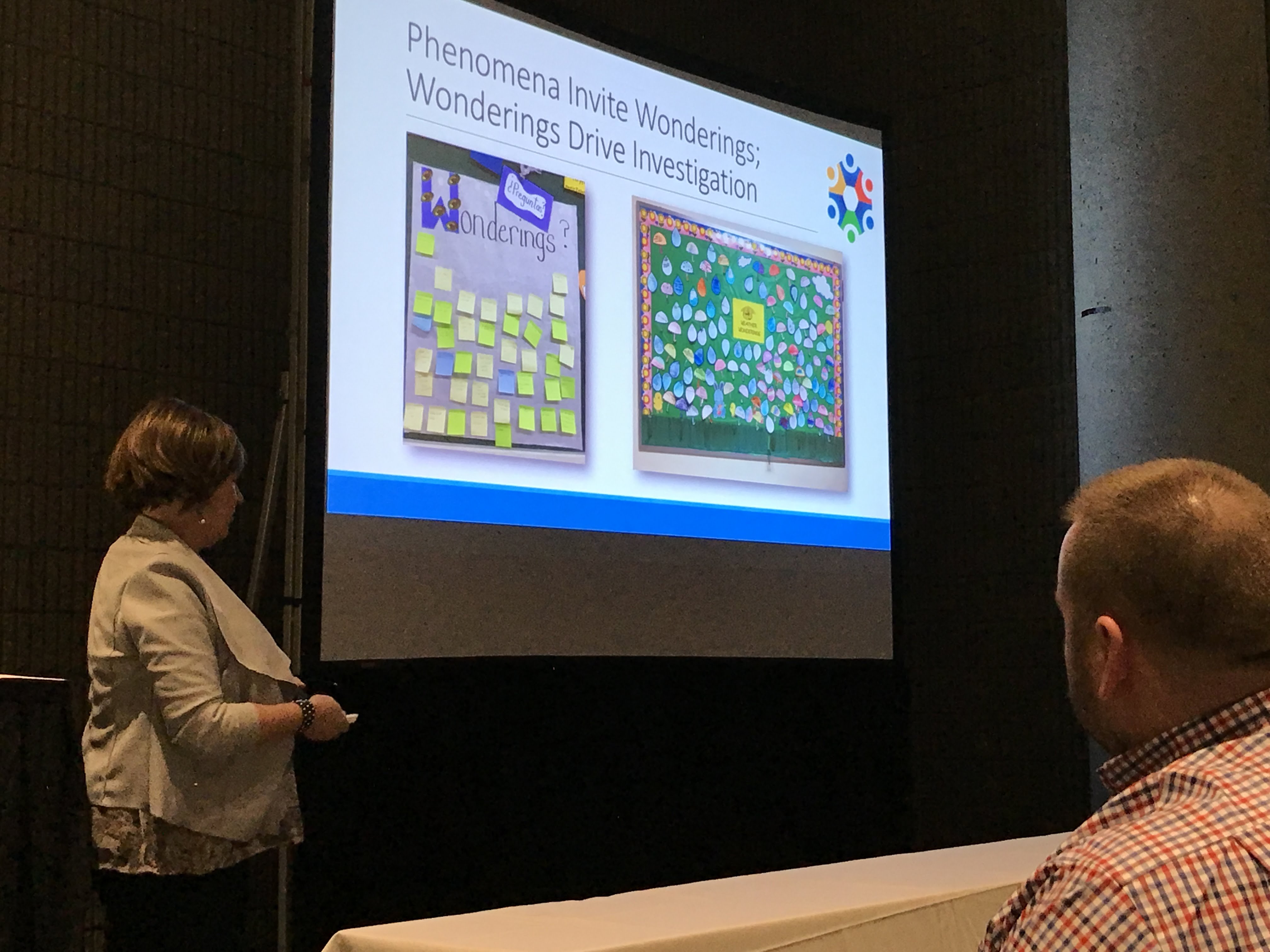 Why, then, do young people become so disinterested in science, often by the time they reach middle school? Even Albert Einstein observed, “It is a miracle that curiosity survives formal education.” Who am I to correct Einstein, but this statement could be modified to say it’s a miracle when curiosity survives formal education. How then do we preserve children’s natural sense of wonder in an era of new standards and change in science education?
Why, then, do young people become so disinterested in science, often by the time they reach middle school? Even Albert Einstein observed, “It is a miracle that curiosity survives formal education.” Who am I to correct Einstein, but this statement could be modified to say it’s a miracle when curiosity survives formal education. How then do we preserve children’s natural sense of wonder in an era of new standards and change in science education?
The Next Generation Science Standards (NGSS), and the Framework on which they are based, describe an ambitious vision for students’ science learning. Three-dimensional science learning–learning core ideas and crosscutting concepts by engaging in scientific and engineering practices–has major implications for traditional curriculum, instruction, and assessment in science. Because NGSS is intended to reflect scientists’ and engineers’ authentic work, it fundamentally serves as a vehicle for promoting curiosity about phenomena. Focusing on phenomena isn’t merely a way to generate interest and excitement, it also should elicit students’ wonderings in ways that produce an overarching question to guide investigation; create a persistent need to explain/understand; and require sustained investigation (STEM Teaching Tool #28). In other words, an emphasis on phenomena and 3-D learning should by their very nature cultivate curiosity about how the world works.
In this post, I identify two common practices in elementary school science that interfere with children’s curiosity, coupled with instructional practices that nurture wonder. As you read, I encourage you to reflect on your own science teaching and share the work you do to nurture children’s innate curiosity about the natural world.
Shifts in Science Teaching Practices That Support Wonder
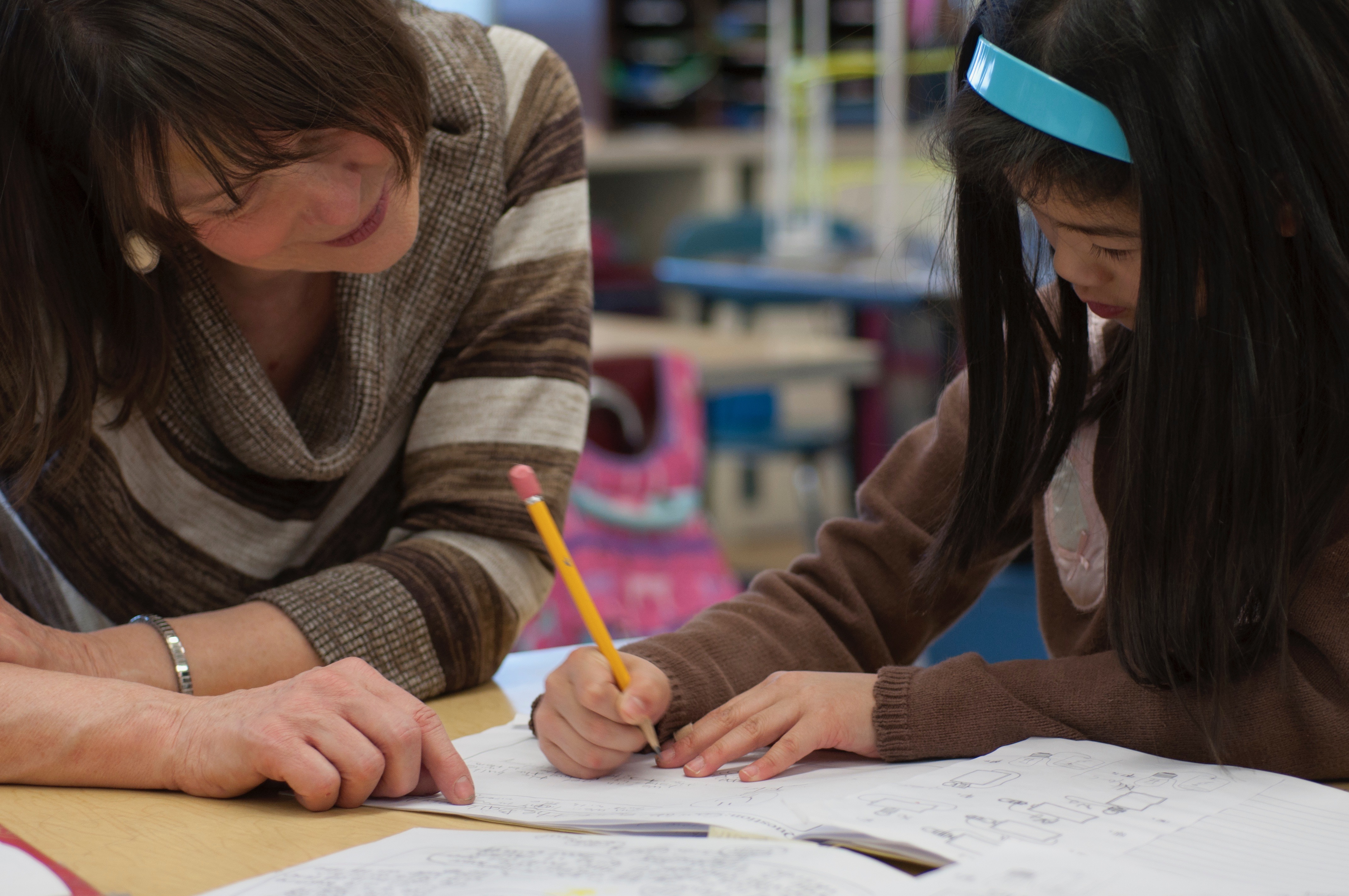 It is commonplace in many school settings to pre-teach vocabulary before engaging in investigations and sensemaking. I have referred to this as “the vocabulary dilemma.” As I worked closely with teacher colleagues, I observed that teaching vocabulary by defining terms appears to stem from traditional ELA instruction and the pressures of high-stakes testing. The practice works against curiosity by focusing on pre-defined terms, which are decontextualized, and represents science as little more than a static body of facts. When taught this way, the focus is on reading, writing, speaking, and listening “about” science.
It is commonplace in many school settings to pre-teach vocabulary before engaging in investigations and sensemaking. I have referred to this as “the vocabulary dilemma.” As I worked closely with teacher colleagues, I observed that teaching vocabulary by defining terms appears to stem from traditional ELA instruction and the pressures of high-stakes testing. The practice works against curiosity by focusing on pre-defined terms, which are decontextualized, and represents science as little more than a static body of facts. When taught this way, the focus is on reading, writing, speaking, and listening “about” science.
So what is the alternative? Tying words to meaning requires engaging with and investigating phenomena while accepting “kid talk” until the point in the sensemaking process that children have enough experiences and emerging understanding of the core idea(s) that it makes sense to introduce the scientific term(s). For example, rather than defining force at the beginning of a unit, allow children to explore a variety of forces. Resist introducing the term until they have enough experiences to make the connection between the word and its meaning in context.
This may sound simple, but resisting the urge to explain and define vocabulary during the act of teaching requires intentional planning for opportunities for children to participate in sensemaking: reading, writing, speaking, and listening “for” science (NRC 2014). Remember that NGSS implementation requires a phenomena-based context in which students themselves are interested and motivated to investigate, explain, and understand.
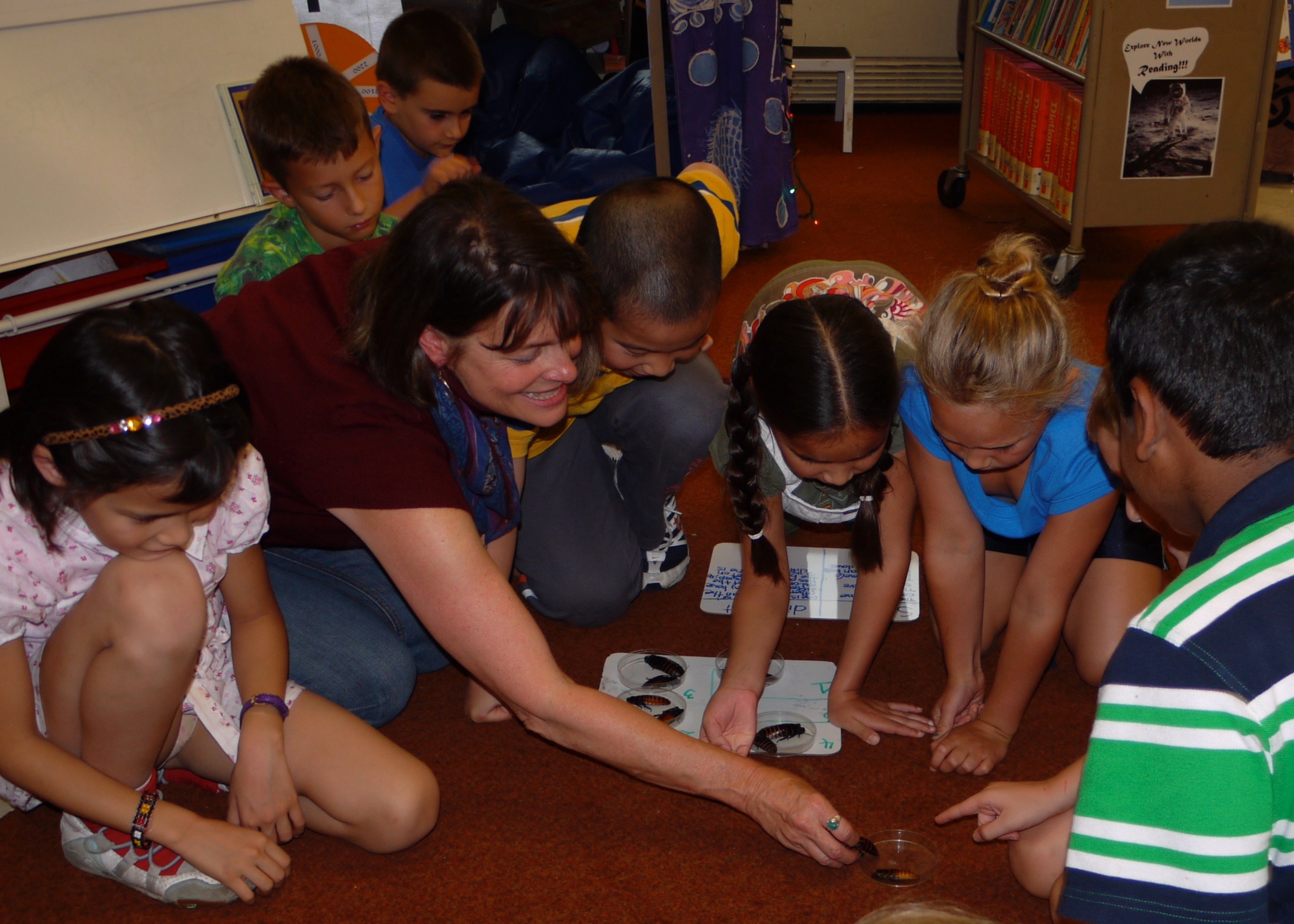 My next example of common practices that inhibit children’s natural curiosity may surprise you. It’s hands-on activities, something a teacher colleague calls “snacks and crafts” science. It is deceiving because when kids are doing activities, they appear to be engaged and having fun. So how does “activity-mania” counteract a sense of wonder? When taught in this way, science may indeed be exciting; however, an activity focus is often driven by science topics or themes and does not build toward a coherent science content storyline (Reiser 2013).
My next example of common practices that inhibit children’s natural curiosity may surprise you. It’s hands-on activities, something a teacher colleague calls “snacks and crafts” science. It is deceiving because when kids are doing activities, they appear to be engaged and having fun. So how does “activity-mania” counteract a sense of wonder? When taught in this way, science may indeed be exciting; however, an activity focus is often driven by science topics or themes and does not build toward a coherent science content storyline (Reiser 2013).
Additionally, collections of fun activities rarely involve students in scientific practices, such as modeling, arguing from evidence, and constructing explanations. Kids may find out “about” cool science facts or see “flash bang” demonstrations, but they are not participating productively in scientific discourse and practices that are essential for sensemaking. So children’s excitement about activities tend to wane as the activity concludes instead of persisting across a unit of study, driven by students’ need to explain and understand some aspect of how the world works.
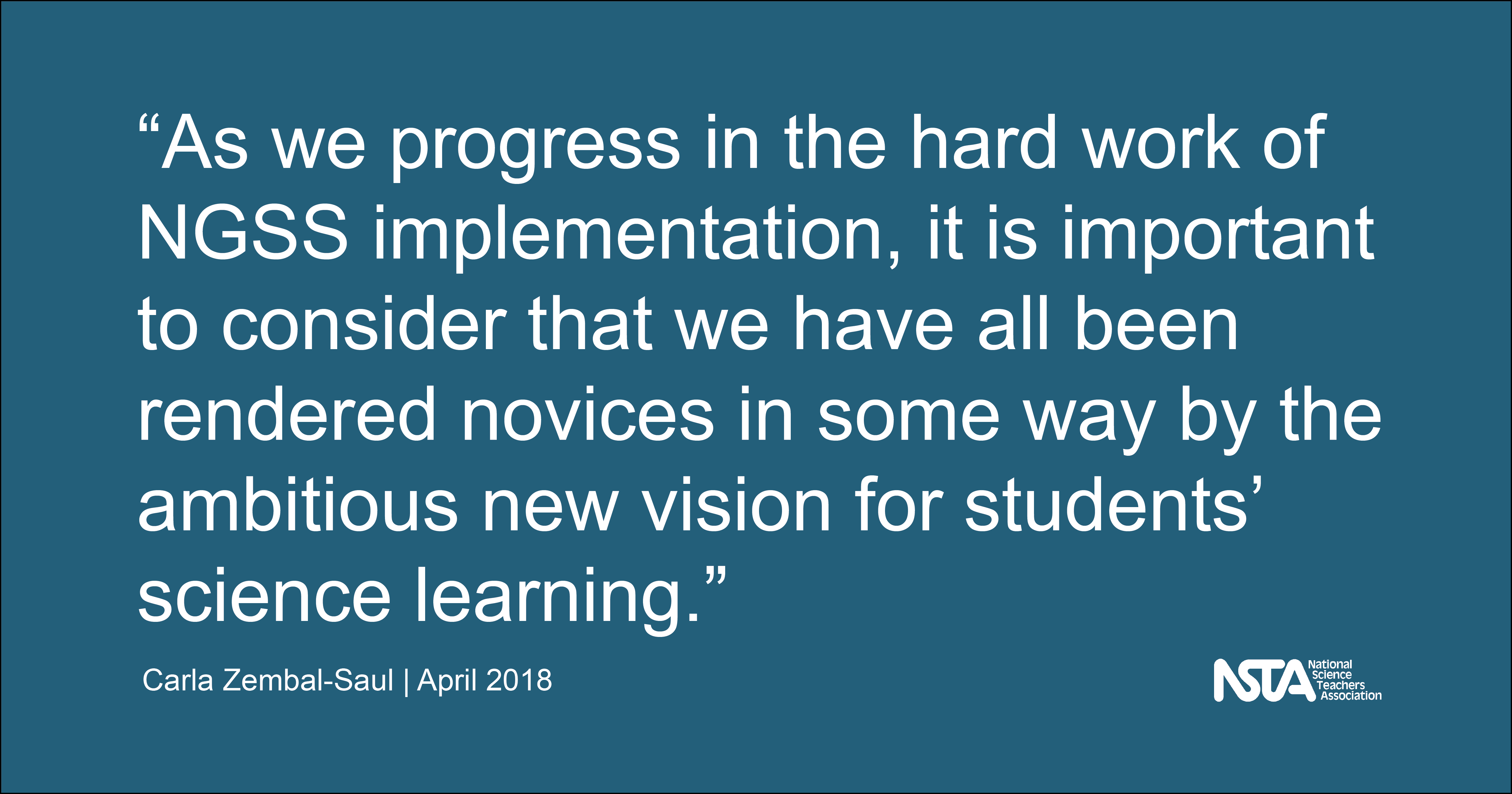
As we progress in the hard work of NGSS implementation, it is important to consider that we have all been rendered novices in some way by the ambitious new vision for students’ science learning. In the end, however, teachers are the ones left to enact the instructional practices that support this vision, often in the isolation of our own classrooms. Change requires us to be curious, not only about the NGSS, but also about how children learn and how our instructional practices impact their learning.
Additionally, we must be willing to share what we find as we engage in inquiry into science teaching and learning with others. In her book A Sense of Wonder, marine biologist and conservationist Rachel Carson describes her wish for every child as an indestructible sense of wonder that lasts a lifetime and protects from the disenchantment that comes with age. My wish for you as an educator is that you, too, will never lose your sense of wonder.
I welcome feedback on your experiences with making these challenging shifts away from pre-teaching vocabulary and activity-mania to tying science words to meaning, and using phenomena to promote coherence across investigations. Please comment below…
 Carla Zembal-Saul is a professor of science education and the Kahn Professor of STEM Education at Penn State University. A former middle school science teacher with a background in biology, she is co-author of the book What’s Your Evidence? Engaging K–5 Students in Constructing Explanations in Science. Zembal-Saul’s research investigates instructional practices and tools that support preservice and practicing elementary teachers in engaging children productively in scientific practices and discourse with an emphasis on sensemaking about natural phenomena. She is deeply invested in practitioner inquiry and video analysis of practice as mechanisms for advancing teacher learning and development. In 2015, Zembal-Saul was recognized as a NSTA Fellow, and she served on the National Academies of Sciences consensus panel that produced the report, Science Teachers’ Learning: Enhancing Opportunities, Creating Supportive Contexts.
Carla Zembal-Saul is a professor of science education and the Kahn Professor of STEM Education at Penn State University. A former middle school science teacher with a background in biology, she is co-author of the book What’s Your Evidence? Engaging K–5 Students in Constructing Explanations in Science. Zembal-Saul’s research investigates instructional practices and tools that support preservice and practicing elementary teachers in engaging children productively in scientific practices and discourse with an emphasis on sensemaking about natural phenomena. She is deeply invested in practitioner inquiry and video analysis of practice as mechanisms for advancing teacher learning and development. In 2015, Zembal-Saul was recognized as a NSTA Fellow, and she served on the National Academies of Sciences consensus panel that produced the report, Science Teachers’ Learning: Enhancing Opportunities, Creating Supportive Contexts.
This article was featured in the April issue of Next Gen Navigator, a monthly e-newsletter from NSTA delivering information, insights, resources, and professional learning opportunities for science educators by science educators on the Next Generation Science Standards and three-dimensional instruction. Click here to access other articles from the April issue. Click here to read more in the April issue. Click here to sign up to receive the Navigator every month.
Visit NSTA’s NGSS@NSTA Hub for hundreds of vetted classroom resources, professional learning opportunities, publications, ebooks and more; connect with your teacher colleagues on the NGSS listservs (members can sign up here); and join us for discussions around NGSS at an upcoming conference.
The mission of NSTA is to promote excellence and innovation in science teaching and learning for all.
Future NSTA Conferences
2018 STEM Forum & Expo
Dive into Three-Dimensional Instruction Workshop
2018 Area Conferences
2019 National Conference
Follow NSTA
At the NSTA National Conference in Atlanta, I was honored to give the Mary C. McCurdy lecture on young children and their natural curiosity about how the world works. Anyone who has ever spent time with them knows they are born scientists who are curious about the natural world and continuously question, test, and try to make sense of it.
Ed News: Amid Walkouts, Charter Fight, Kentucky Commissioner Forced to Resign
By Korei Martin
Posted on 2018-04-23

This week in education news, Kentucky Education Commissioner Stephen Pruitt resigns under pressure from the Governor and State Board; a new report from Achieve includes criteria states can use to develop NGSS tests; women who watched The X-Files pursued more careers in STEM; and a wrap on the 2018 March for Science.
Amid Walkouts, Charter Fight, Kentucky Commissioner Forced to Resign
Kentucky Education Commissioner Stephen Pruitt, an affable former science teacher who led the state through an upending of its school accountability system, dramatic budget cuts, and teacher walkouts over pensions, abruptly resigned under pressure Tuesday . . . “Despite the outcry of tens of thousands of Kentuckians, today Gov. Matt Bevin continued his offensive against public education, this time through proxies and behind closed doors,” Kentucky Education Association President Stephanie Wikler said in a statement. “Dr. Stephen Pruitt has been a strong and effective champion for our students and public schools. Forcing an honorable and highly qualified man to resign from his position without any cause is contrary to the best interests of students across the commonwealth.”
Achieve Gives Guidance to States on Developing Well Rounded Science Assessments
Recently released criteria from Achieve can be used by states to develop NGSS grade-level tests. Finding success, a new report advised, will require states becoming sticklers in three areas: using “intentional design”; supporting design decisions and rationales through evidence; and reflecting more comprehensive learning goals.
Women Who Watched ‘The X-Files’ Pursued More Careers In STEM
When The X-Files premiered in 1993, FBI agent and medical doctor Dana Scully was unlike any other woman on television. Scully, played by Gillian Anderson, was equal to, and not just the sidekick of, Fox Mulder (David Duchovny). She was sharp, resilient, fiercely intelligent, and working a career that most women hadn’t seen themselves in onscreen. The idea of women becoming interested in the scientific field as a result of Scully has been known for years as “The Scully Effect”–and now there’s data to back it up.
The Second March for Science a Smaller Affair
Far fewer came out to support the April 14 March for Science than last year’s estimated 100,000 attendees.
Stay tuned for next week’s top education news stories.
The Communication, Legislative & Public Affairs (CLPA) team strives to keep NSTA members, teachers, science education leaders, and the general public informed about NSTA programs, products, and services and key science education issues and legislation. In the association’s role as the national voice for science education, its CLPA team actively promotes NSTA’s positions on science education issues and communicates key NSTA messages to essential audiences.
The mission of NSTA is to promote excellence and innovation in science teaching and learning for all.
Follow NSTA

This week in education news, Kentucky Education Commissioner Stephen Pruitt resigns under pressure from the Governor and State Board; a new report from Achieve includes criteria states can use to develop NGSS tests; women who watched The X-Files pursued more careers in STEM; and a wrap on the 2018 March for Science.
The Wow Factor
By Gabe Kraljevic
Posted on 2018-04-23

What are some activities that I can plan for the next school-year of science with that will excite my students for the lessons to come?
— C., Arkansas
There are a host of demonstrations and hands-on activities that can impress a class and start off the year with a real rush! Try conducting quick science, technology, engineering, and mathematics (STEM) challenges using drinking straws and tape that get students moving the first day and teach teamwork. Break the class into small teams to build something. For instance, each team can be responsible for one part of a tower that will be built in half an hour. In 30 minutes stop and assemble all the pieces into a monstrous structure!
Discrepant events are also exciting and thought-provoking. Find ones that match your curriculum but be sure to test them out before demonstrating them. Alternatively, provide groups of students with simple discrepant activities and have them try to explain them to the class. The Brain-Powered Science: Teaching and Learning with Discrepant Events series by Thomas O’Brien (published by NSTA Press) features a multitude of discrepant events.
Give teams several science brain-teasers and demonstrations and tell them that if they can adequately explain them all you will give their team an A for the entire course on the first day! Obviously make these too hard, but the students will be excited and they will argue with you about what the correct explanation is!
Hope this helps!

What are some activities that I can plan for the next school-year of science with that will excite my students for the lessons to come?
— C., Arkansas
Equity & Access: Policies and Best Practices for Science Educators
By Korei Martin
Posted on 2018-04-19
The Multicultural and Equity Committee is rolling out a new NSTA blog on topics of equity. The intent is for the blog to allow readers to discuss and highlight policies and best practices that promote and sustain educational equity for all students. We also hope the blog will provide a place where readers can share ideas, and stay connected with topics, resources and events related to equity.
We will use the National Research Council’s A Framework for K-12 Science Education to help contributors to the blog showcase resources and strategies that focus on diversity of the stakeholders in science education. We hope the blog will provide a platform to discuss the challenges and meaningful solutions related to the allocation of time, resources and expertise needed to create space for educators to authentically engage all students. Ultimately, we hope that our blog posts will work to foster environments that address systemic inequities, eliminate educational barriers, and will afford access and equity for all students.
Let us hear from you! Do you have an equity-related question or a challenge you would like to see addressed in this blog? What resources, policies, and strategies do you find effective? Are you interested in writing for this blog? Email us at meg.delgato@gmail.com or natacia.campbell@gmail.com.
Natacia Campbell is Chair of the NSTA Committee on Multiculturalism and Equity in Science Education. She is with Joliet Public Schools District 86. Meg Delgato is Academic Chair, College of Education for St. Petersburg College in Florida, and a member of the NSTA Equity Committee.
The mission of NSTA is to promote excellence and innovation in science teaching and learning for all.
Future NSTA Conferences
- Philadelphia, July 11–13
- Reno: Oct. 11–13, 2018
- National Harbor (MD): Nov. 15–17, 2018
- Charlotte: Nov. 29–Dec. 1, 2018
- St. Louis (National): April. 11–14, 2019
Follow NSTA
The Multicultural and Equity Committee is rolling out a new NSTA blog on topics of equity. The intent is for the blog to allow readers to discuss and highlight policies and best practices that promote and sustain educational equity for all students. We also hope the blog will provide a place where readers can share ideas, and stay connected with topics, resources and events related to equity.
Ideas and inspiration from NSTA’s April 2018 K-12 journals
By Mary Bigelow
Posted on 2018-04-17
Regardless of what grade level or subject are you teach, as you skim through the article titles, you may find ideas for lessons that would be interesting for your students or the inspiration to adapt/create your own.
For example, there are definite overlaps between the lesson ideas in Citizen Science and Real-World Connections. Many citizen science projects are appropriate for both elementary and secondary classrooms.
And take a look at NSTA’s online journal Connected Science Learning for more real-world and citizen science projects.
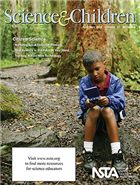 Science & Children – Citizen Science
Science & Children – Citizen Science
Editor’s Note: Citizen Science “Citizen science opportunities provide real-life experiences that link what students are doing in school to what is happening in the world. They can feel a part of the effort to increase our knowledge about topics that impact their lives. This can be rigorous science reflecting what scientists do while also building solid disciplinary core ideas in the sciences…Students feel empowered with the ability to make a difference through citizen science projects and as a teacher you will likely to feel empowered as well.”
The lessons described in the articles have a chart showing connections with the NGSS and many include classroom materials, illustrations of student work, and photographs of students at work. They also include contact information on the Citizen Science projects used in the lessons.
- In addition to describing their community water quality project, the authors of Water Warriors note that “place-based environmental education and citizen science clearly work in conjunction to strengthen each other. The mix of student engagement and content mastery, while working with community partners, produces experiences that impact students’ lives for years to come.”
- Formative Assessment Probes: Uncovering Students’ Ideas About Watersheds would be a way to assess students’ prior knowledge before starting a water-quality project.
- Real Science in the Palm of Your Hand provides a framework to help teachers use citizen science resources for meaningful science learning in the three NGSS dimensions. (Take a look at a student project, too)
- Fourth graders mentor first graders through a project in Tracking Nature With Technology. The students participated in a bioblitz to study the diversity of the schoolyard using technology to record and send observations and photographs.
- Nurturing Local-to-Global Thinking demonstrates a multi-disciplinary activity in which third-graders combined environmental science, geography, reading, technology, and data analysis in comparing local and faraway places.
- Given A Global Perspective, students collect local soil samples as they share their own data, ask questions, and analyze data from different parts of the world.
- The Early Years: Introducing Children to Phenology has suggestions for experiences in which younger students make observations and collect data about their environment using cameras, drawings, and simple arithmetic. (Phenology–the scientific practice of observing and collecting information on the timing of life cycle changes in plants and animals)
- In addition to recommending trade books, Teaching Through Trade Books: Beneath Our Feet has two lessons (Engineering a City K-2) and Sketching the Sea Floor (3-5) that help students understand how changes on Earth occur over time and how humans have an impact on Earth systems.
These monthly columns continue to provide background knowledge and classroom ideas:
- Science 101: How Does a Thermos “Know” to Keep Hot Liquids Hot and Cold Liquids Cold?
- Science 102: Frozen Coke
- The Poetry of Science: Science Is Us!
- Methods and Strategies: Reading With a Purpose
- Engineering Encounters: The Giant Problem: Using design thinking to explore thermal conductivity
- Teaching Teachers: Learning From Failure
For more on the content that provides a context for projects and strategies described in this issue, see the SciLinks topics Biodiversity, Buoyancy, Conduction Convection and Radiation, Dynamic Earth, Heat and Temperature, Insects, Ocean Floor, Polar Climates, Soil, Soil and Climate, Water Erosion, Water Quality, Watersheds
Continue reading for Science Scope and The Science Teacher
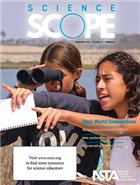 Science Scope – Real-World Connections
Science Scope – Real-World Connections
From the Editor’s Desk: Real-World Connections for Your Student Scientists Partnerships with scientists, real and virtual field trips, citizen science projects can make science students into student scientists. “Go beyond the typical lab and involve your students in collecting authentic data both in your own community and from all parts of the globe… Give students opportunities to be scientists and they will learn problem-solving skills, practice teamwork skills, and think outside the box. They will begin to make meaning out of their world and better understand nature, their bodies, and the universe.
Articles in this issue that describe lessons include a helpful sidebar (“At a Glance”) documenting the big idea, essential pre-knowledge, time, and cost; many follow a 5E format. The lessons also include connections with the NGSS, and many include examples of student work, assessments, and classroom materials.
- Citizen Science: Prepare an Ant Picnic for Science illustrates a real-world scenario as students explore the food preferences of ants and compare their data with that of citizen scientist around the world.
- Partnerships between scientists and student-scientists are the focus of two articles–Engineering Partnerships makes the connections between science and engineering in a study of deep-ocean hydrothermal vents. The Evolution of a Partnership shows a collaboration to use ongoing research to clarify evolutionary concepts. “Not all science takes place in a lab…sometimes scientists can sue naturally occurring ‘experiments’ to study how evolution takes place.” These articles have suggestions for finding research partners for your student-scientists.
- Bridging the Gap Between “Rocks for Jocks” and the Mars Sample Return Program has a 5E lesson to apply mineral identification process to rock samples from Mars.
- A field trip becomes An Ecosystem Experience, as student scientists apply math, modeling, and sampling to collect authentic data.
- Classic Lessons 2.0: What kind of person becomes a scientist?
- Disequilibrium: Inseparable Magazines describes a 5E lesson on friction using a discrepant event.
- Three articles this month have teacher suggestions for planning, implementing, and follow-up for guest speakers in the classroom: Science For All: Be Our Guest!, Listserv Roundup: Guest Speakers and Mentors for Career Exploration in the Science Classroom and Integrating Technology: Web Conferencing for Student Engagement
- Teacher To Teacher: Using Models to Explain Their Thinking suggests ways to overcome misconceptions students have about models and modeling in science.
These monthly columns continue to provide background knowledge and classroom ideas:
- Scope on the Skies: Gaining Insight Into Mars
- Teachers’s Toolkit: Communicate Effectively With Parents and Family Members Through a STEM Newsletter
For more on the content that provides a context for projects and strategies described in this issue, see the SciLinks topics Careers in Science, Ecosystems, Electron Microscope, Food Chains, Friction, Hydrothermal Vents, Identifying Minerals, Inner Planets, Insects, Migration, Photosynthesis, Predator/Prey
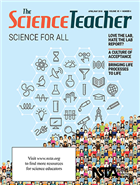 The Science Teacher – Science for All
The Science Teacher – Science for All
Every April, this is the theme for The Science Teacher. As noted in the Editor’s Corner: Science for All these issues “have been providing teaching ideas and strategies to narrow the academic achievement gaps associated with ethnicity, socioeconomic status, gender, physical disabilities, limited English-language proficiency, and learning differences…The current issue adds to this literature with suggestions for engaging reluctant writers and tactics for creating a classroom culture that values LGBTQ youth.”
The lessons described in the articles include connections with the NGSS (including DCIs) and many include classroom resources and illustrations of student work.
- A Culture of Acceptance has suggestions for classroom management and language that includes LGBTQ students.
- Love the Lab, Hate the Lab Report? describes an alternative to traditional lab reports: an intervention lab report that includes mini-posters and presentations (similar to what we see at conferences!). The article has strategies to get all students participating.
- Bringing Life Processes to Life, especially for English Language Learners, is a challenge. The author provides examples of how to use models for topics such as DNA replication, transcription, translation, and other processes. Photographs illustrate the models, which can be helpful for all students.
- Students assume the role of regional planners as they investigate ways of Using the Land, looking at the pros and cons of development in terms of runoff, habitats, and environmental impact.
- Understanding Earthquakes integrates Model-Based Inquiry into a challenging study of earthquakes and related processes.
- Focus on Physics: The Slowing of Light in Glass includes a novel graphic model to help students understand a complex concept.
- Idea Bank: The Protein Résumé illustrates how to get students to create new ways to present information, rather than copy/paste from the Internet.
These monthly columns continue to provide background knowledge and classroom ideas:
For more on the content that provides a context for projects and strategies described in this issue, see the SciLinks topics Biomedical Engineer, DNA Replication, Earthquakes, Energy Transfer, Environmental Decision-Making, Land Use, Plate Tectonics, Proteins, Transfer of Sound and Light Energy, Transcription, Translation, Tsunamis
Regardless of what grade level or subject are you teach, as you skim through the article titles, you may find ideas for lessons that would be interesting for your students or the inspiration to adapt/create your own.
From Vision to Reality: Making the NGSS Come Alive in Every Classroom
By Carole Hayward
Posted on 2018-04-16
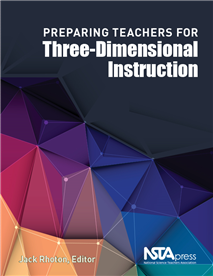 The Next Generation Science Standards (NGSS) are ushering in an exciting new era of science education where three-dimensional learning integrates core ideas, science and engineering practices, and crosscutting concepts to deliver an education that prepares today’s students to become “effective, rational thinkers able to contribute to (and cope with) our complex and constantly changing societies,” writes Bruce Alberts in the foreword to NSTA’s new book, Preparing Teachers for Three-Dimensional Instruction.
The Next Generation Science Standards (NGSS) are ushering in an exciting new era of science education where three-dimensional learning integrates core ideas, science and engineering practices, and crosscutting concepts to deliver an education that prepares today’s students to become “effective, rational thinkers able to contribute to (and cope with) our complex and constantly changing societies,” writes Bruce Alberts in the foreword to NSTA’s new book, Preparing Teachers for Three-Dimensional Instruction.
Alberts, who serves as the Chancellor’s Leadership Chair for Science and Education at the University of California, San Francisco and is the President Emeritus of the National Academy of Sciences, acknowledges that the NGSS require substantial shifts in the way preservice science teachers are trained as well as to the professional development practicing science educators receive so that science educators can empower their students to become effective problem solvers who make wise decisions for ‘themselves, their families, and their nation.”
While the book’s primary audience is preservice education teachers, science education faculty and practicing K-12 science educators will also benefit from reading it. The instructional practices that K-12 science educators are using to unlock the vision behind the NGSS as well as the shifts being made to the entire field of science education—by higher education science faculty, science teachers, teacher education faculty, and others—are showcased in this book.
Five major sections organize the book’s 18 chapters which are written by outstanding classroom teachers and science educators at all levels:
Section 1
Shifts in Teacher Knowledge and Practice: Models of Teaching to Meet the Intent of the NGSS
Some of the nation’s most outstanding science teachers share how they are using three-dimensional strategies in their classrooms as they transition their teaching of science from inquiry to science as practice. NGSS-aligned curriculum planning and methods of assessment are also addressed in this section.
Section 2
Professional Development Strategies That Support the Implementation of the Framework and the NGSS
Examples of professional development strategies to help K-12 science teachers address specific subject matter as well as proven instructional activities that promote critical thinking and depth of understanding are covered in this section.
Section 3
Teacher Preparation Courses for Preservice Teachers
The nation’s future science teachers need to be equipped with the knowledge and tools to design lessons, assessing students, implement strategies, and evaluate outcomes. This section discusses ways higher education faculty are supporting future teachers’ understanding of three-dimensional learning by giving them opportunities to build capacities and demonstrate their knowledge as they construct explanations, analyze and interpret data, develop models, and engage in argumentation from evidence.
Section 4
Undergraduate Science Course for Preservice Science Teachers
Future science teachers cannot embrace the paradigm shift called for by the NGSS if they have never seen models of context and content in their undergraduate science courses as well as in their teacher education preparation programs. Higher education instructors, in this section, describe some of the changes they made as well as the challenges they have encountered in revamping their teaching techniques.
Section 5
Epilogue: Three-Dimensional Instruction Beyond the Classroom
Teachers know that it takes business-education partnerships to ensure that K-12 students are obtaining the skills and knowledge they need for success in higher education and the workplace. This section explores the work of East Tennessee State University’s (ETSU) Center of Excellence in Mathematics and Science Education as well as ETSU Northeast Tennessee STEM Hub. Guidance is also provided in this section for leaders to use in forming new partnerships, establishing shared goals, and encouraging ongoing contributions to meet those shared goals.
Book editor Jack Rhoton, in the preface, acknowledges the “daunting, complex, and time-consuming task” of fully implementing the vision of the NGSS.
“There is no magic wand for achieving the vision. Instead, educators will need to apply a variety of approaches and efforts over an extended period of time. We believe that the contents of this volume will serve as a motivating resource for the science education community that helps them to harness skills, expertise, and passion as they look to revitalize science instruction.”
Read the free sample chapter to learn how the authors engaged preservice teachers in evidence-based augmentation and helped them assess their own science content knowledge, augmentation skills, and ability to plan instructional activities centered on augmentation.
Making the vision of the NGSS come alive in every K-12 science education classroom will take more than teachers just reading the new standards and aligning their content to the curriculum. This book supports students in becoming true practitioners of science by supporting the transition away from formulaic classroom instruction that far too many students continue to experience.
This book is also available as an e-book.
Follow NSTA
 The Next Generation Science Standards (NGSS) are ushering in an exciting new era of science education where three-dimensional learning integrates core ideas, science and engineering practices, and crosscutting concepts to deliver an education that prepares today’s students to become “effective, rational thinkers able to co
The Next Generation Science Standards (NGSS) are ushering in an exciting new era of science education where three-dimensional learning integrates core ideas, science and engineering practices, and crosscutting concepts to deliver an education that prepares today’s students to become “effective, rational thinkers able to co
Homework Conundrum
By Gabe Kraljevic
Posted on 2018-04-16

A colleague and I were wondering what type of homework works best for our students? How do we hold them accountable?
— N., California
In general, you have to be flexible and adapt to your classes. Different courses, units, and students will create different conditions for homework to be useful. Topics like balancing equations, math/physics word problems, genetics crosses, and others that follow an algorithm require practice and repetition. Projects that require more time than you can afford in class also can be done at home. Give students time in class to get their feet wet in a topic while you are there to provide support. This time is critical to ensure that the students understand what they are taking home and that you know where they are in their understanding.
Varying your approach will keep students on their toes. You can sometimes just do a check, other times collect homework papers and grade them. I often asked students to pull out their homework and I just walked around, giving them a small mark for completion. I might even give them partial credit for partially completing homework!
There are some concerns with work completed outside of class: students may copy from others; parents or siblings may ‘unteach’ your lessons; and students may have little free time outside of school. To mitigate these concerns, I rarely gave daily homework and almost never asked for work to be done in one night. This reduced pressure to copy, allowed students to plan around activities and time to ask me questions.
Hope this helps!
Photo Credit: Tony Alter from Newport News, USA

A colleague and I were wondering what type of homework works best for our students? How do we hold them accountable?
— N., California


